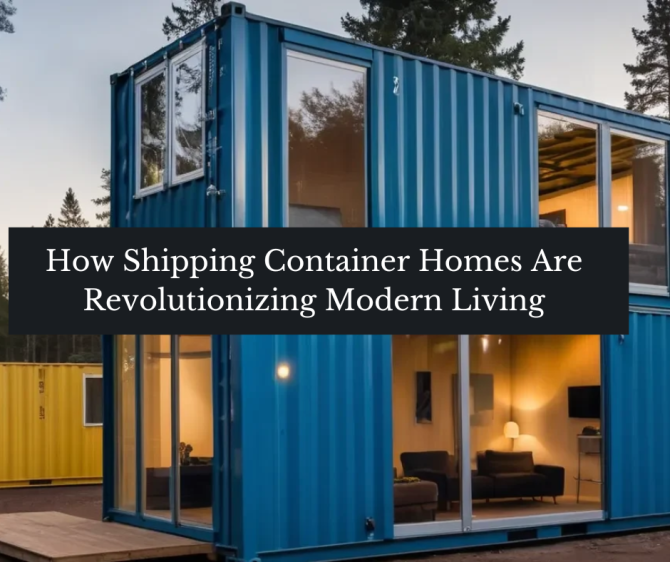Shipping container homes are becoming an increasingly popular alternative to traditional home designs. The shipping container home industry has grown rapidly over the last few years and is expected to continue to grow into the future.

What Is a Shipping Container Home?
A shipping container home is a dwelling made from steel shipping containers—large reusable intermodal containers that transport goods. Shipping containers are available in two sizes: 20 feet by 8 feet or 40 feet x 8 feet: The 20-foot containers are 160 square feet, while the 40-foot shipping containers offer 320 square feet of living space. You can use these containers as a standalone home or personal office, or you can combine multiple containers to create a multilevel residence. Shipping container homes, like tiny houses, RVs, or silo homes, are rising in popularity as potential homeowners seek out alternative building solutions to the traditional multi-bedroom house.
Advantages of Shipping Container Homes
If you are interested in the lifestyle of downsizing from a traditional house to something smaller and more versatile, such as a shipping container home, it might be the right choice for you. But let’s go over the pros of this decision first.
1. Can Be More Cost-Effective Than Typical Residences
While this is no guarantee, shipping container homes tend to cost less than traditional housing in the long run. Not only are shipping containers usually cheaper to purchase by themselves, but they are also less expensive to turn into a decent dwelling customized to your exact specifications.
2. Ease of Mobility & Transportation
Suppose you keep the overall structure of the shipping container intact when turning it into a home. In that case, they can be easily transported across countries and even oceans making it easy to embrace mobility and move wherever you want. This is done by shipping companies that can offer transport services even for modified shipping containers, delivering them worldwide by boat, truck, or train.
3. Easily Customizable
The options for customizing and modifying your shipping container home are nearly endless. You can select multiple containers to create a multi-story structure or combine different sizes for an individualized layout. Additionally, shipping containers are reasonably easy to modify internally, as well. You just need the right tools to cut holes for windows, doors, and stairwells into the container itself to create the perfect dwelling for you.
4. Eco-Conscious Option
Though they are not made of particularly eco-friendly materials, it’s still an environmentally conscious decision to turn a shipping container into your home. Instead of letting it lie around a shipping yard and go to waste or becoming refuse in a landfill, you are giving this object a second life as a home.
5. Energy Efficiency
It’s much easier to heat and illuminate these small spaces than to warm an entire house. You will impose fewer supply needs on the infrastructure and environment around you and have lower utility bills as a result. Plus, it takes less energy consumption to transform a shipping container into a home than it does to build an entirely new residence from scratch!
6. Incredibly Secure
Considering the steel that these prefabricated shipping containers are made of, you don’t have to worry about burglars gaining access to your alternative dwelling. It is quite hard to successfully break into a metal box, after all!
7. Made of Durable Material
As mentioned, these units are generally made of reinforced or galvanized steel, allowing them to be shipped across massive distances and often under the influence of terrible weather conditions. As a result, shipping container homes benefit from being incredibly hardy and durable, with low instances of your typical residential wear and tear.
Disadvantages of Shipping Container Homes
And while there certainly are benefits to living in an alternative housing structure, like a shipping container home, there are also disadvantages to this lifestyle. It’s time to examine some cons of this alternative living style.
1. Appliances Don’t Always Fit
Shipping containers are not built with modern appliances in mind, so altering them to include your typical home setup of dishwashers, stoves, ovens, washers, or dryers can be difficult. You will need to put in a custom electrical system, as well as special plumbing to make toilets flush and water run, which needs to be done by a specialist in this field and will cost more than a DIY job.
2. Building Permits Can Be Difficult to Get
You generally need very specific permits and zoning permissions for turning a shipping container into a home, as they are technically classed as a non-permanent structure. And some municipalities won’t even let you set up a shipping container as your home, depending on local housing regulations. So, it can be difficult to figure out the fine print of finding a place to put your alternative-style dwelling.
3. Contractors Are Hard to Come By
Not everyone can work with shipping containers, and specialist contractors or builders who have experience with turning these units into successful living spaces can be difficult to find and expensive to hire.
4. Need to Consider the Climate
Because of the metal construction of shipping containers, it can be hard to achieve temperature regulation inside the structure, particularly in very hot or cold climates. It takes a lot of insulation and airflow to help maintain control of the temperatures, so setting up your dwelling in the far North or a tropical location might not be the best idea.
How Much Are Shipping Container Homes?
Most homeowners can expect to pay between $25,000 and $250,000 for this eco-friendly, small-space living solution, with luxury alternatives reaching $400,000 or more. A shipping container home typically costs $150 to $350 per square foot. Shipping container homes cost significantly less than traditional housing options, making them an attractive choice for budget-conscious buyers. If you're wondering how much shipping container homes cost, prices can vary widely based on size, design, and finishes. For those asking, "How much are shipping container homes?" the answer depends on factors like location and customization.
Costs and Planning for Shipping Container Homes
Discover the costs and planning connected with shipping container homes.
1. Budgeting Beyond the Container
It’s easy to get excited about the low price of containers, but don’t forget the additional costs. You’ll need to budget for things like:
-
Site preparation and foundation work
-
Electrical and plumbing systems
-
Insulation and interior finishes
-
Permits and inspections
These factors can add up quickly, so it’s essential to plan.
2. Building Codes and Permits
Not every location is prepared to accept shipping container dwellings. Some places have severe zoning rules or building codes, which might make construction difficult. Check your local restrictions before you begin to avoid any surprises.
Shipping Container Home Ideas for Modern Living
Shipping container homes have become very popular, especially among young people. There are many ways to customize a shipping container and make it a very modern living space for your family.
Minimalist Living: A shipping container home is ideal for those who value minimalism. A single-container structure provides just enough space for the basics, leaving no place for excess clutter. Including built-in furniture or foldable tables can increase usefulness without dominating the space.
Multi-Container Family Homes: Need more space? Not an issue. Stacking or combining containers allows you to create a family-friendly home with many bedrooms, a large kitchen, and even outdoor decks. The modular design allows you to easily construct a configuration that fits your lifestyle.
Read also: What Is A Prefab House? Pros, Cons, and Cost
Conclusion
Shipping container homes are more than just a trend, they’re a smart, sustainable solution to the challenges of modern housing. Whether you’re drawn to their affordability, environmental benefits, or endless design possibilities, they’re worth considering.
The key to success is planning. Understand the costs, know your local regulations, and take your time designing a home that works for you. With a bit of creativity, you can turn a steel container into a stylish, comfortable, and functional living space.
So, what’s stopping you? Could a shipping container home be your next big move? Learn more about different types of homes and the home-buying process.


